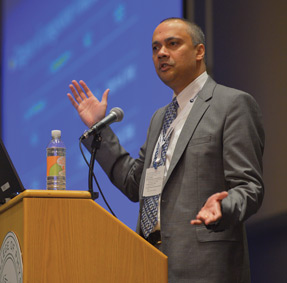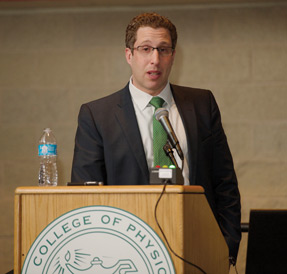Emphasize exercise for CAD testing, disease prevention
Exercise capacity is the single most power predictor of cardiovascular events, whether or not symptoms are present.
Sex can be a great motivator when it comes to getting chronic coronary artery disease (CAD) patients to take an exercise stress test, said Steve Kopecky, MD, FACP, during a talk on chronic CAD at the Cardiology for the Internist precourse at Internal Medicine 2014.
“We often have patients come in and say they want us to tell their spouses that it's OK to have intercourse,” said Dr. Kopecky, a professor of medicine in the division of cardiovascular diseases at Mayo Clinic in Rochester, Minn. “The test is helpful for showing patients it's OK to exercise.”

Indeed, the exercise stress test has many advantages as a diagnostic and risk stratification tool for chronic CAD patients who are able to go 5 metabolic equivalents (METS), which is about 2 flights of stairs or 2 blocks (walked vigorously).
For one, exercise stress testing offers more information than pharmacologic stress testing because the inability to exercise in and of itself is associated with increased cardiovascular risk, he said. “The reason for not being able to exercise could be a bad foot, but still, the inability itself increases the risk,” he said.
Also, exercise capacity is the single most powerful predictor of cardiovascular events, whether or not symptoms are present. “It's more predictive than blood pressure, chest pain, an echo scan and ST-elevations,” he said.
Ischemia at a low workload indicates a greater likelihood of severe disease and a worse prognosis than does the same degree of ischemia at a high workload, he noted. “Using an exercise stress test documents the workload that induces ischemia, so you have a benchmark exercise level you can tell the patient,” he said.
Another advantage of the exercise stress test is that it is nearly as accurate as an imaging stress test for correctly identifying patients with left main or 3 vessel CAD and for predicting outcomes. “The higher sensitivity of the imaging stress [test] is due to detection of more patients with 1 or 2 vessel disease,” he said.
As for exercise testing after revascularization, it is useful for determining the immediate result of the revascularization, but keep in mind the optimal effects aren't typically seen until about 6 weeks after the procedure. At 6 months or more after revascularization, exercise testing can be used to help in evaluation and treatment and in guiding the best cardiac rehabilitation program and return-to-work plans, he said.
Other types of cardiac testing
Patients unable to exercise for 5 METS can do pharmacologic stress testing, the choice of which will depend on the patients' profile. For asthma and heart block patients, dobutamine is fine, but adenosine and dipyridamole will exacerbate the asthma and heart block. On the other hand, dobutamine is contraindicated for patients with poor control of hypertension, recent transient ischemic attacks (TIAs), or glaucoma, or those who are on high-dose beta-blockers, he said.
Stress cardiac imaging tests are often overused and are a huge target for professional societies like ACP and the American College of Cardiology, as well as the American Board of Internal Medicine's Choosing Wisely campaign, Dr. Kopecky noted. “We really, really overdo them.”
For example, the American College of Cardiology advises against stress imaging in initial evaluation of patients without cardiovascular symptoms (except high-risk patients); annual stress imaging as routine in asymptomatic patients; and stress imaging preoperatively in low-risk patients with noncardiovascular surgery.
The American Society of Nuclear Cardiology, meanwhile, says not to perform stress imaging—or coronary angiography—in patients without symptoms unless they are high risk; advises against cardiovascular imaging in low-risk patients; and says not to use cardiovascular preoperatively in intermediate or low-risk noncardiovascular surgery patients, he noted.
However, stress imaging does have advantages with certain conditions, including left bundle-branch block, Wolff-Parkinson White syndrome, paced rhythm, left ventricular hypertrophy with strain, digoxin therapy, a >1 mm ST-segment depression at rest, and history of coronary revascularization. In these situations, imaging can “add accuracy, localize ischemia, measure LVEF, and provide useful information when combined with stress testing,” he said.
Exercise for prevention
Dr. Kopecky also promoted exercise for chronic CAD patients—really, all patients—in a different sort of setting: as secondary prevention. Only 22% of U.S. adults exercise the recommended amount of more than 150 minutes per week, he noted.
“I find it helps if I tell my patients to think of exercise as ‘vigorous leisure activity,’” he said. “And for those who say they don't have time, remind them that if you don't exercise, you'll have to find time later for disease.”
Even low-level physical activity is helpful, he added. Fifteen minutes per day of exercise 6 days a week reduces cardiovascular mortality by 20%, with the benefits increasing with more exercise. “The health benefits are seen immediately, and the mortality benefits are seen within 2 years,” he said.
Meanwhile, cardiovascular mortality risk starts to lower with just 10 minutes of vigorous activity 3 times per week, he added. At 1,080 exercise calories per week, cardiovascular death risk is lowered by 75%, he said.
The most effective aerobic training incorporates interval training, in which rather than maintaining a continuously elevated heart rate at, for example, 120 beats per minute (bpm), the patient aims to reach a heart rate of 140 bpm for intervals of 30 to 120 seconds, then dip down to 110 to 120 bpm, then ramp back up to 140 bpm, over a period of 30 minutes, Dr. Kopecky said.
“The benefits of using intervals include that they raise HDL cholesterol more [than continuous-rate exercise]; lower LDL cholesterol particle counts more; use more calories; promote more blood vessel dilation; and lead to better fitness and less boredom,” he said.




